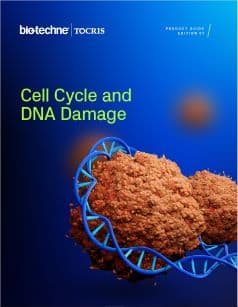Hsp70
Hsp70 (70 kDa heat shock protein) is a molecular chaperone that is involved in protein folding and the protection of proteins from damage during stress. The expression of Hsp70 is increased under conditions of thermal stress or in the presence of toxic chemicals.
Hsp70 Inhibitors |
|
|---|---|
| Cat. No. | 产品名称/活性 |
| 2653 | Pifithrin-μ |
| Inhibitor of p53-mitochondrial binding; also inhibits Hsp70 activity | |
| 3803 | VER 155008 |
| Hsp70 inhibitor | |
Hsp70 Activators |
|
| Cat. No. | 产品名称/活性 |
| 6703 | BGP 15 |
| Activates Hsp70 protein 1 (Hsp72); also PARP inhibitor | |
Other |
|
| Cat. No. | 产品名称/活性 |
| 4621 | MKT 077 |
| Binds mot-2; selectively cytotoxic in cancer cells | |
Hsp70 (70 kDa heat shock protein) is a molecular chaperone that is involved in protein folding and the protection of proteins from damage during stress. The expression of Hsp70 is increased under conditions of thermal stress or in the presence of toxic chemicals such as heavy metals.
Hsp70 binds in an ATP-dependent manner to sequences of hydrophobic residues. These can be on nascent polypeptide chains emerging from the ribosome, or exposed on other proteins by stress conditions. Binding by Hsp70 promotes folding of newly synthesized or mis-folded proteins to their native state. Hsp70 also prevents non-native protein aggregation by binding along with co-chaperones of the J-domain protein (JDP) family to hydrophobic residues of substrate molecules shielding them from other intermolecular attractions.
Hsp70 interacts with numerous eukaryotic regulatory proteins including nuclear receptors, kinases (e.g. Raf-1) and transcription factors. Hsp70 also acts in concert with other chaperones (e.g. Hsp90) and is regulated by a number of co-chaperones/accessory proteins (e.g. p23, Cdc37).
Hsp70 also interacts with key regulatory proteins ('clients') of signal transduction pathways for the control of cell homeostasis, proliferation, differentiation and cell death. For example, Hsp70 is involved in the caspase pathway and acts as a general antiapoptotic agent (such as Bcl-2) that inhibits heat shock-induced apoptosis. Hsp70 prevents the activation of caspase-3, PARP cleavage, DNA laddering and therefore apoptotic cell death- but has no effect on cytochrome c release.
Hsp70 family members include the constitutively expressed chaperone Hsc70, which facilitates protein folding and GRP-78 (78kDa glucose-regulated protein) involved in the transportation of proteins to the endoplasmic reticulum.
Literature for Hsp70
Tocris offers the following scientific literature for Hsp70 to showcase our products. We invite you to request* your copy today!
*Please note that Tocris will only send literature to established scientific business / institute addresses.
Cell Cycle and DNA Damage Research Product Guide
This product guide provides a review of the cell cycle and DNA damage research area and lists over 150 products, including research tools for:
- Cell Cycle and Mitosis
- DNA Damage Repair
- Targeted Protein Degradation
- Ubiquitin Proteasome Pathway
- Chemotherapy Targets
Hsp70 Gene Data
| Gene | Species | Gene Symbol | Gene Accession No. | Protein Accession No. |
|---|---|---|---|---|
| Heat shock 70kDa protein 1A | Human | HSPA1A | NM_005345 | P08107 |
| Mouse | Hspa1a | NM_010749 | Q69616 | |
| Rat | Hspa1a | NM_212504 | Q6LA95 | |
| Heat shock 70kDa protein 1B | Human | HSPA1B | NM_005346 | P08107 |
| Mouse | Hspa1b | NM_010478 | P17879 | |
| Rat | Hspa1b | NM_31971 | Q07439 | |
| Heat shock 70kDa protein 1-like | Human | HSPA1L | NM_005527 | P34931 |
| Mouse | Hspa1l | NM_013558 | P16627 | |
| Rat | Hspa1l | NM_212546 | P55063 | |
| Heat shock 70kDa protein 5 | Human | HSPA5 | NM_005347 | P11021 |
| Mouse | Hspa5 | NM_022310 | P20029 | |
| Rat | Hspa5 | NM_013083 | P06761 | |
| Heat shock 70kDa protein 8 | Human | HSPA8 | NM_006597 | P11142 |
| Mouse | Hspa8 | NM_031165 | P63017 | |
| Rat | Hspa8 | NM_024351 | P63018 |
